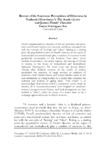Mostrar o rexistro simple do ítem
Beware of the Sorceress: Perceptions of Otherness in Nathaniel Hawthorne’s The Scarlet Letter and Joanne Harris’ Chocolat
| dc.contributor.author | Domínguez Rué, Emma | |
| dc.date.accessioned | 2016-07-15T08:35:23Z | |
| dc.date.available | 2016-07-15T08:35:23Z | |
| dc.date.issued | 2008 | |
| dc.identifier.citation | AEDEAN 2008, 31: 11-19 ISBN-978-84-9749-278-2 | |
| dc.identifier.isbn | 978-84-9749-278-2 | |
| dc.identifier.uri | http://hdl.handle.net/2183/17033 | |
| dc.description.abstract | [Abstract] Freud’s psychoanalytical theories of fear of castration and penisenvy transformed woman into not-man, and hence associated her with the concepts of “lacking” and “other”. Taking as a starting point the popularised version of Freud’s theories on the topics of womanhood and motherhood, plus a number of reactions to this patriarchal construction of the feminine from more recent feminist theoreticians, this article explores the concept of alterity in relation to the issues of womanhood and motherhood. Nathaniel Hawthorne’s The Scarlet Letter and Joanne Harris’ Chocolat offer different versions of the notion of alterity, particularly the rejection of single mothers as emblems of otherness: both Hester Prynne and Vianne Rocher arrive in the new community as young women in a society that venerates the authority and wisdom of ageing males. “The Other” is an acknowledged rival without which a community cannot shape its identity, be it seventeenth-century New England or twentiethcentury Lansquenet-sous-Tannes, and both protagonists are thus marked as “other”, either by means of a scarlet letter or by a campaign against chocolate in church sermons | |
| dc.language.iso | eng | |
| dc.publisher | Universidade da Coruña | |
| dc.title | Beware of the Sorceress: Perceptions of Otherness in Nathaniel Hawthorne’s The Scarlet Letter and Joanne Harris’ Chocolat | |
| dc.type | info:eu-repo/semantics/conferenceObject | |
| dc.rights.access | info:eu-repo/semantics/openAccess |






